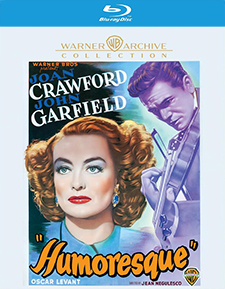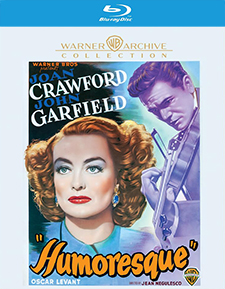Humoresque (1946) (Blu-ray Review)

Director
Jean NegulescoRelease Date(s)
1946 (November 26, 2024)Studio(s)
Warner Bros. (Warner Archive Collection)- Film/Program Grade: B-
- Video Grade: A
- Audio Grade: A
- Extras Grade: B
Review
Classical music has had a spotty history in mainstream movies. In 1940, Walt Disney produced Fantasia, disparate animated sequences inspired and accompanied by famous pieces in the classical canon. Classical selections also formed the bases of soundtracks in A Song to Remember, Immortal Beloved, Amadeus, 2001: A Space Odyssey, Death in Venice, and many others. In Humoresque, a Warner Bros. melodrama, classical music is the catalyst that sets the plot in motion.
Paul Boray (John Garfield, Body and Soul) fell in love with the violin as a child, when his father (J. Carroll Naish, Rio Grande), a neighborhood grocer, bought him a cheap one. Ever since, Boray has devoted himself to practicing and improving his technique. As an adult, he hangs out with his pianist buddy Sid Jeffers (Oscar Levant, The Band Wagon). Both friends strive for success in the world of serious music but not many jobs in classical orchestras are available in the midst of the Great Depression. Sid takes any piano jobs he can get but Boray can’t reconcile himself to such a compromise. He gets occasional work in orchestras, but his outspokenness gets him fired from one job after another.
Jeffers takes Boray to a fancy party hosted by wealthy, married socialite and arts patron Mrs. Helen Wright (Joan Crawford, Mildred Pierce). At the insistence of another guest, Boray plays his instrument and that gets the attention of the hostess. He’s rude to her but, intrigued by his talent and unfiltered manner, she takes an interest in him. They talk about his ambition and she decides to use her connections and influence to further his career.
With Helen’s guidance and encouragement, Boray’s concert career gathers traction and he plays bigger and better venues. Helen is drawn romantically to her protege and soon, he has romantic feelings for her. At this point, the film turns into standard soap opera, with the love triangle of Boray, Helen, and Boray’s music. He’s obsessed with his art and his career and can think of little else but music and Helen. He ignores his sweetheart, Gina (Joan Chandler, Rope), with no explanation, and rebuffs his mother (Ruth Nelson, A Tree Grows in Brooklyn) when she cautions him against pursuing a relationship with a married woman.
Joan Crawford is top-billed but doesn’t show up until about a half-hour in. When we first see her character, she’s standing across the room from Boray as he plays. At the first strains of his violin, she takes note, asks for her glasses so she can see clearly who’s playing, and she’s impressed. (Helen’s dons glasses periodically throughout the film but Crawford makes sure they’re off for most of her close-ups.) Crawford makes clear that Boray sparks a passion in Helen that the relationship with her husband lacks. Crawford was familiar with playing long-suffering women and gives the role of Helen her all, eliciting a degree of sympathy for her character. But the film’s finale, cutting back and forth between Boray triumphing at a concert as Helen, alone in her beach house, listens to the concert on the radio and reacts with increasing histrionics, is the kind of scene that Carol Burnett could have parodied. The scene’s seemingly endless length (likely to last the length of the Tristan and Isolde selection being played) makes Crawford look downright ridiculous.
Garfield never looks comfortable as the impassioned violinist. Known for rougher roles, he’s cast against type and it’s hard to accept him as a dedicated musician driven by his love of music. Isaac Stern performed the selections that Garfield supposedly plays in the film. Those are Stern’s hands when we see in close-ups the fingering and bowing, but camera angles and some trickery give the impression that, when we see Garfield playing, he’s exhibiting masterful musicianship.
Oscar Levant offers a welcome helping of comic relief and does his own piano playing. His throwaway lines are very funny, but you have to listen carefully, since he underplays his delivery. Levant has a wonderful sense of self-deprecation. He would often pop up in movies as a friend or sidekick and usually have at least one scene showcasing his piano artistry. His acting range wasn’t great and he usually played himself or a character patterned after him.
Director Jean Negulesco elicits decent performances from Garfield and Crawford but hampered by a clunky screenplay by Clifford Odets and Zachary Gold. With lines like Helen’s “Let me alone, Paul, I’m a lost crusade,” the dialogue gets pretty silly, and it’s a marvel that Crawford can deliver the lines with a straight face. At just over $2 million, the film was costly for the time but it did well at the box office and grossed 3.4 million domestically and in foreign markets.
Humoresque is notable today for the breadth of music it contains. Often, movies would feature only a smattering of classical selections because they were thought to slow the action, but here music is one of the stars, with Isaac Stern’s playing dominating the soundtrack with works by Dvorak, Tchaikovsky, Bizet, Mendelssohn, Prokofiev, Shostakovich, Bach and others.
Humoresque was shot by director of photography Ernest Haller on 35 mm black & white film with spherical lenses, finished photochemically, and presented in the Academy aspect ratio of 1.37:1. The Warner Archive Blu-ray features a HD master from a 4K scan of the original nitrate camera negative. Clarity and contrast are first rate, with atmospheric lighting and flattering close-up lighting emphasizing Crawford’s strong bone structure. Blacks are deep and velvety. A climactic scene uses somewhat softer focus, likely to underscore the mental torment of Crawford’s character. Through deft blending of John Garfield with the hands of professional violinists, the actor looks as if he’s actually playing the difficult pieces himself. Close-ups of Isaac Stern’s hands bowing and fingering complete the illusion.
The soundtrack is English 2.0 DTS-HD Master Audio. English SDH subtitles are an available option. Dialogue is clear and distinct. The musical sequences receive serious attention and are highlighted by violin solos and Levant’s masterful piano playing. In addition to the classical selections, the film includes partial renditions of My Heart Stood Still, I Guess I’ll Have to Change My Plan, What Is This Thing Called Love?, Embraceable You, and Zing! Went the Strings of My Heart. Franz Waxman’s score is incidental.
Bonus materials on the Blu-ray release from the Warner Archive Collection include the following:
- The Music of Humoresque (9:45)
- Racketeer Rabbit (7:54)
- Rhapsody Rabbit (7:38)
- Theatrical Trailer (2:39)
The Music of Humoresque – Film historian Rudy Behlmer and several classical artists discuss the relationship of music to characters in Humoresque. The music of the concert hall and the world of symphonic music are important to the story. Franz Waxman brought a feel for action to the film. He wanted Jascha Heifetz to provide the violin playing but Heifetz wanted too much money, so virtuoso Isaac Stern was hired. The musical numbers were pre-recorded by the orchestra and Stern and 16 mm films were made all Stern’s performances so that John Garfield could study his hand movements. In some scenes, two violinists behind Garfield actually played—one did the fingering, the other the bowing. The music from Carmen and Tristan and Isolde represented famous love stories. The latter is “dramatic, peaceful, passionate, reflective.”
Racketeer Rabbit – In this 1946 Looney Tunes Technicolor cartoon directed by Friz Freleng, Bugs Bunny is looking for a place to bed down for the night and winds up at a farmhouse that’s the hideout of two gangsters, Rocky and Hugo (ringers for Edward G. Robinson and Peter Lorre). They return to their hideout, pursued by rival gangsters. When Rocky and Hugo discover Bugs, the rabbit tricks them into giving up all their stolen loot by wearing assorted disguises. A staged police raid, Bugs’ quick thinking, and the gangsters’ gullibility result in Bugs’ outsmarting his not-too-bright adversaries. Voice characterization is provided by Mel Blanc.
Rhapsody Rabbit – On the concert stage, piano virtuoso Bugs Bunny is about to play Franz Liszt’s Hungarian Rhapsody No. 2. He’s interrupted by a persistent cough from an unseen audience member, and resorts to extreme ways to silence the distraction. During his performance, a mouse becomes yet another disturbance. In the climax, even though the mouse steals Bugs’ moment in the spotlight, the rabbit concludes the performance with good humor. This 1946 Technicolor Merrie Melodies cartoon was directed by Friz Freleng with Bugs Bunny voiced by Mel Blanc.
Humoresque is an interesting film for Garfield and Crawford as both attempt to stretch their dramatic ability. Garfield comes off better as the driven musician whose life revolves around music to such a degree that he’s nearly immune to Crawford’s considerable allure. Crawford, on the other hand, covers familiar ground as an adulterous woman whose tragic flaw is falling for a man whose music is his guiding force. The glorious music elevates the film from pure soap opera to “serious picture” but never achieves the level of a classic. Oscar Levant and J. Carroll Naish are welcome cast members, as they infuse wit and humor into an otherwise conventional screenplay.
- Dennis Seuling

